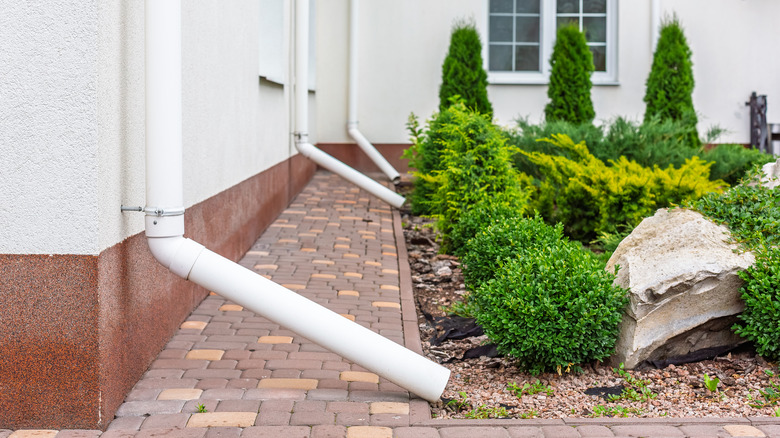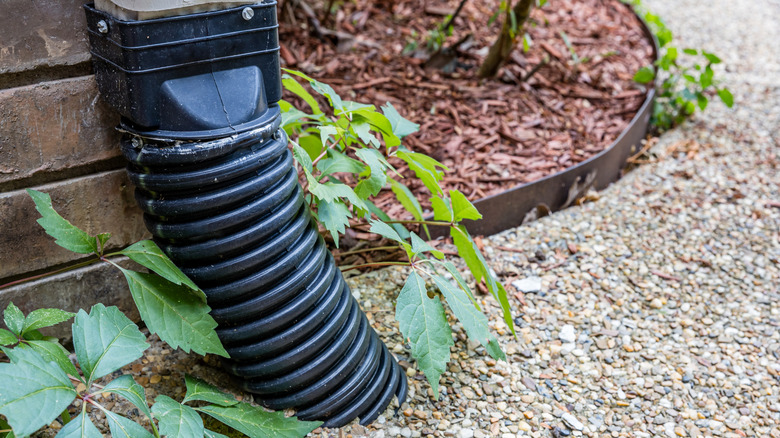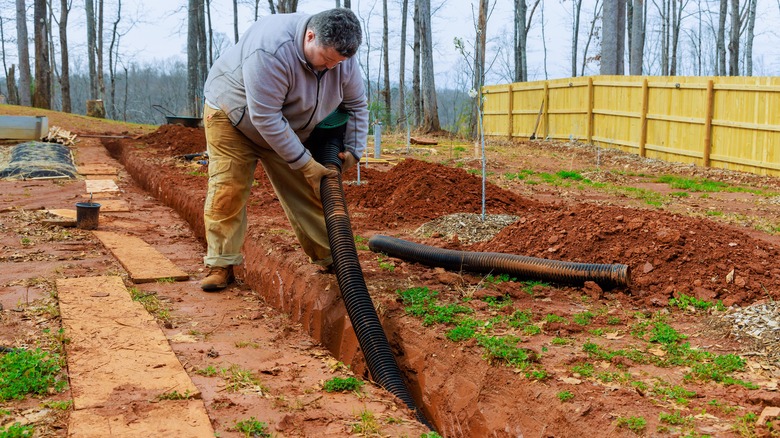Say Goodbye To The Eyesore Of Downspouts With One Sleek DIY Solution
Downspouts are often a necessary home feature for preventing flooding and water damage. While there are other ways to divert water away from your house without gutters, many homeowners find downspouts to be the most effective. However, though common, downspouts aren't exactly the most attractive. While folks might use downspout extensions to direct water away from the home and out into other parts of the lawn, these long tubes can become an eyesore, hurting your curb appeal and becoming a nuisance when mowing. However, a clever DIY solution can help you hide your downspout extension while still retaining all of the benefits it provides. By burying your downspout extension underground, you can divert water away from the house without hindering your curb appeal.
While you could turn the unsightly downspout in your yard into a stunning display instead, hiding it is sometimes more practical and minimalistic. However, it's important to note that a downward slope is ideal to best divert water, as a flat or upward slope could cause back-flooding in the pipe. Also, burying your downspout extension might make it more difficult to clean out the line if there is a clog. Installing a filter system or regularly cleaning gutters to prevent leaves and debris from trailing through the downspout could help prevent this issue, though. Another consideration is that gaps in the pipe where connectors join two different sections could cause leakage, which would be more difficult to repair if underground. Also, cold underground temperatures could cause some pipes to freeze or crack, impacting their effectiveness.
Hide the downspout extension underground for an unobtrusive look
For this DIY project, you'll need a vented downspout filter or a downspout adapter, a narrow shovel, a hacksaw, and a flex tube or PVC for your extension. According to French Drain Man on YouTube, you'll also want to have an in-line catch basin, a pop-up emitter, and roughly twenty-five feet of three-inch corrugated pipe to create your extension. Start by measuring your gutter downspout to find out what size extension kit you'll need. Common US sizes include three-inch and four-inch measurements. Next, plan where you'll lay your extension pipe and use a narrow shovel to dig three to four inches down. Work slowly so you don't accidentally come into contact with any underground lines. While you shouldn't interrupt any utilities if you dig a shallow path, it's good to contact the utility company prior to digging.
It's generally recommended to work on a one-percent downward slant, if possible. While your flexible pipe can lie flat for roughly up to ten feet, having a downward slope will best direct water. Avoid having an upward slope at any point down the line. When attaching the downspout adapter, be sure there is enough room for your corrugated pipe to achieve a smooth, 90-degree elbow. Maintain a downward slope here to prevent backflow. Then, add any catch basins, a pop-up emitter at the end, and begin filling your trench with packed dirt to cover the pipe.
What to consider before installing a downspout extension
Alternative burying methods for installing a downspout extension might use PVC pipe, different attachment pieces needing screws, glue, or multiple pipes with connectors. Some experts suggest digging a larger trench that is six inches wide and ten inches deep. However, for the DIY described above, French Drain Man argues this is not necessary since the corrugated pipe is only three inches and is flexible enough to maneuver around utility lines.
There are several different downspout extensions to consider to save your home's foundation from water damage, but when using an underground system, having an in-line catch basin is a good addition to help manage debris through the pipes. French Drain Man suggests installing the in-line catch basin roughly seven feet down the line from the adapter. Catch basins are great for collecting smaller debris, like worn shingles or seeds that the adapter might not filter out.
Depending on your preference, you could also choose different drainage techniques at the water exit point. French Drain Man uses a pop-up emitter with holes drilled into the PVC elbow for drainage. The emitter is installed below the grass so that a lawn mower can go over it without causing damage. However, other experts dig a 16-by-36-inch trench at the end, fill it halfway with gravel, lay the end of the pipe, and add more gravel on top for drainage.


